Join More Than 50,000+ Subscribers and get latest camera news and rumors
NEW CAMERA VIDEOS ON YOUTUBE
|
By admin, on April 24th, 2025
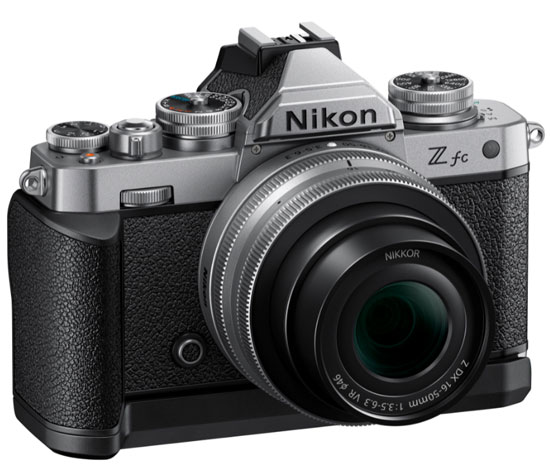
Nikon announced multiple firmware updates for its cameras; among the three, Nikon ZFC has the longest list of updates. Take a look at the details below
Z fc firmware Ver.1.80
• The following phenomena have been fixed.
– When connected to SnapBridge and Wi-Fi, if the Setup menu’s Connect to smartphone > Communications when powered off is set to On, and then the camera is turned off and the lens is removed, the values would remain displayed on the LCD panel.
– If you looked through the viewfinder with the picture monitor closed, and then pressed the release button halfway just before pressing the playback button to switch to the playback screen, the display in the viewfinder might not be correct.
– If you looked through the viewfinder with the Picture Control settings screen displayed from the i menu, the display might not be correct.
Z 50 Firmware Ver.2.60
• Fixed an issue where frames would not advance correctly when pinching out to enlarge an image taken in portrait orientation.
COOLPIX P1000 Firmware Ver.1.8
• Fixed an issue that occasionally caused the camera to stop responding to operations when taking continuous shots.
Follow us on our social pages FACEBOOK | TWITTER | INSTAGRAM to get live Camera News + Nikon Rumors 24X7
By admin, on August 12th, 2024
Let’s discuss the best entry-level camera for photographers. In this particular article, we will compare all the entry-level camera sensors at high ISO range to each other to find out the best of all.
The list of cameras that we have included in this test starts with Sony’s most popular 24-megapixel APS-C CMOS sensor. The Sony 24-megapixel APS-C BSI CMOS sensor is being used in the following models:S
Sony A6100
Sony ZV-E10 Mark II
Sony A6400
We have selected Nikon’s famous 20-megapixel APS-C CMOS sensor, being used in these Nikon cameras:
Nikon Z30
Nikon Z50
Nikon Zfc
And finally, Canon’s 24-megapixel APS-C DPAF CMOS sensor, the latest generation of the sensor, is being used in:
Canon R50
Canon R10
The Canon R100 camera sensor as well as the processor used in R100 is not coming straight from Canon’s latest generation of sensors, so we are putting this camera on the sap-rate list
From the editor’s desk:
In this comparison, we will be evaluating the image sensors of all these cameras together to find out which one performs best in low-light and uncontrolled lighting environments.
Are you planning to buy a new camera for photography? Whether you’re interested in kids’ photography, shooting portraits of your family and friends, capturing landscapes, architecture, or even wildlife photography, in any of these scenarios, you will be exposed to uncontrolled lighting environments.
What does an uncontrolled lighting environment mean? It means dealing with natural light, which is not always perfect as per your requirements.
So, what does a photographer do to adjust for natural light? They generally raise the ISO level to balance the exposure.
The truth is, If your camera sensor cannot perform well at high ISO levels, then it’s likely not the right choice for you. In this comparison, we will be reviewing all these models so you can easily find the best camera for your needs.
1. Canon R100 vs Canon R10/R50
We are comparing Canon are 100 camera versus The Canon R10 / r50 by picking up the ISO 12800 now let’s see the image below and discuss the result
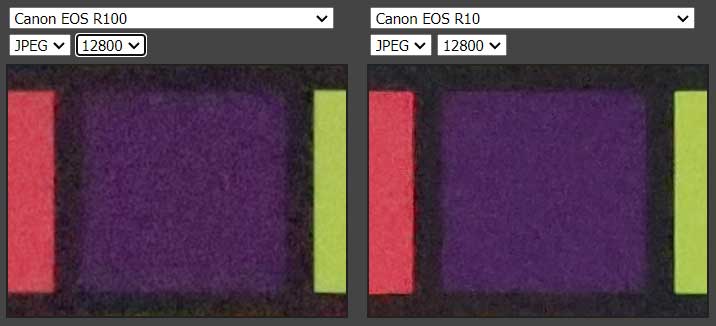
As seen in the test results, you can clearly notice that the image sample captured at ISO 12800 with the Canon R100 camera does not preserve details as well as the Canon R10.
What could be the reason behind this? It could be due to the older generation of the sensor or perhaps the older generation of the image processor used in the Canon R100. It could be either of these two factors, but the end result is clear: the Canon R50 camera’s sensor performs much better compared to the Canon R100.
Verdict: Winner Canon R10/Canon R50 Camera
2. Canon R10/R50 vs Sony ZV-E10/A6400
Now it’s time for the most interesting comparison. We are comparing the Canon R10 and R50’s 24-megapixel Dual Pixel CMOS autofocus sensor with Sony’s 24-megapixel Hybrid CMOS autofocus sensor, which is used in the Sony ZV-E10, Sony A6400, and Sony A6100 cameras. This comparison will be very interesting to see which one performs better under various conditions.
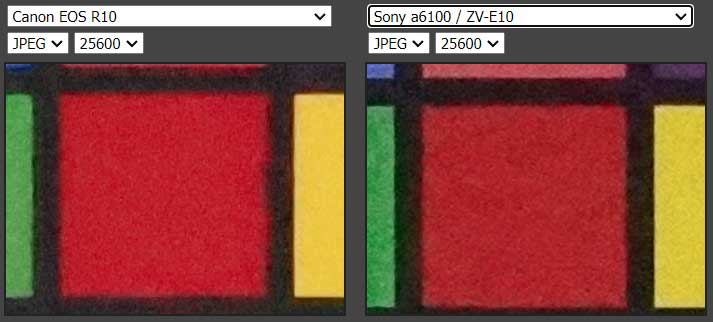

From the image samples, it is very clear that Sony’s 24-megapixel Hybrid CMOS autofocus sensor is able to capture slightly more detail—or rather, it’s better to say it’s able to preserve slightly more detail—compared to the Canon R10 and Canon R50’s 24-megapixel Dual Pixel CMOS autofocus sensors.
We’re not talking about a major difference, but there is a noticeable one. You can observe it in the corners and edges of the color blocks, where the sharpness and details are better preserved by Sony’s sensor at high ISO ranges compared to the Canon R10.
Verdict: Winner Sony ZV-E10 | Sony A6400 Camera
3.Sony ZV-E10/A6400 vs Nikon Z30/ Z50
Now it’s final test time, and we are comparing the Sony ZV-E10 or the Sony A6400 camera Hybrid CMOS autofocus sensor with the Nikon Z30 or Z50. We do have a slight resolution difference between them, and we will be comparing both at the same. Let’s find out the difference we have.
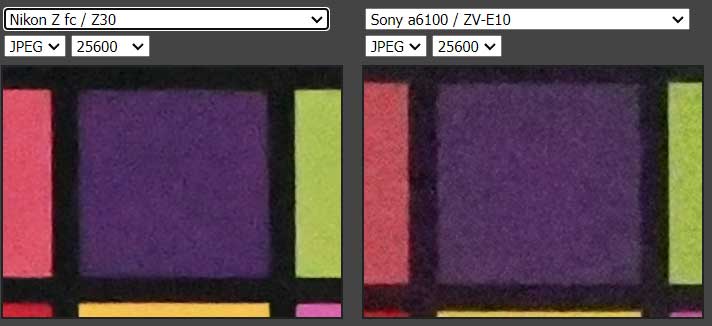
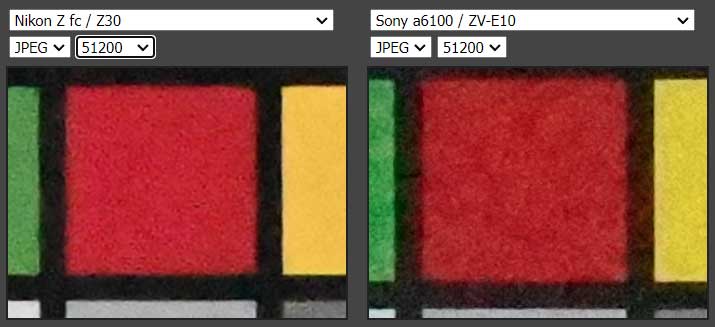
We have selected two different image samples at two different ISO levels. The first one is at ISO 25600, and the other set of samples is at ISO 51200. In both images, it is clearly visible that the Nikon Z30, Zfc, or Z50 20-megapixel Hybrid CMOS autofocus sensor wins by a margin. It preserves a bit more detail; the corners and the borders are a bit clearer and better preserved compared to the image samples we have on the right side from the Sony A6100 or the Sony ZV-E10.
From the test, it’s very clear that the 20-megapixel Hybrid CMOS autofocus sensor of the Nikon Z30 is able to preserve a bit more detail.

Final Result and the Winner
If you are going to combine all the tests and conclude a result, then the clear winner in the entry-level zone is the Nikon Z30, Z50, or Zfc with the 20-megapixel Hybrid CMOS autofocus sensor. If you want to shoot amazing images in uncontrolled light or low-light environments, then without a doubt, even in 2024, this sensor is best for you.
Get Nikon Z30 | Nikon Z50 | Nikon Zfc from Amazon.com | B&H Store
PS: Keep in mind that several other factors are also involved, like the autofocus system, continuous burst speed, and types of autofocus modes, but we are discussing the most important part here: the image quality, which matters the most to a photographer.
We Need Your Love and Support: How can you support TheNewCamera.com? Simply by purchasing your new camera, lens, or any other accessories through our affiliate links, which will help us maintain this website.
source image credit – www.dpreview.com/reviews/image-comparison
By admin, on August 23rd, 2021
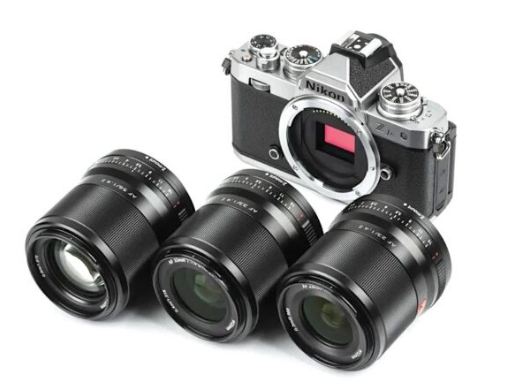
Nikon Zfc camera doesn’t have a low-pass filter. During the high ISO test, dpreview team members found that the Nikon ZFc camera doesn’t have a low-pass filter inside it. The test result of the camera looks similar to Nikon Z50 and Sony A6400 which also doesn’t have a low-pass filter inside them.
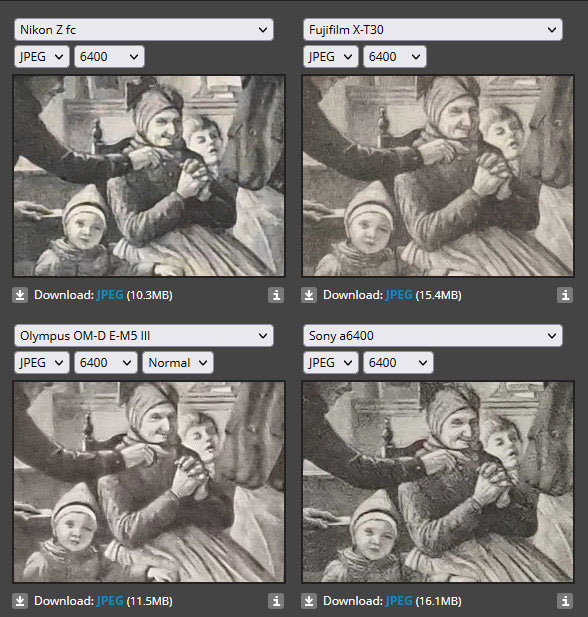
One of the most surprising things you may notice in the test is the amount of details captured by Nikon Zfc at ISO 6400 when compared to 26MP BSI CMOS sensor of the Fuji X-T30.
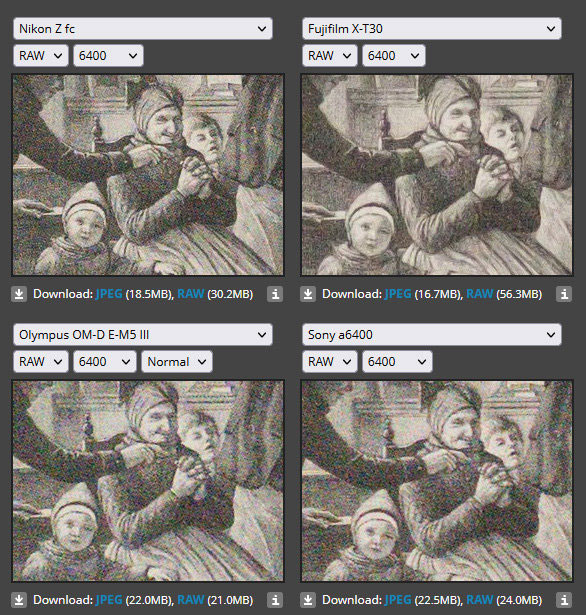
The key point here is the size of the JPEG file, as you can see Nikon manages to preserve more data than Fuji when we compare the size of RAW files vs the JPEG one. At the same time, we have OMD -EM5 III and Sony A6400 with heavier RAW files than the Nikon Zfc but they are able to grab fewer details as well as the color noise is more. So, it’s very clear that Nikon uses an optimum method for JPEG conversion from RAW files and preserves more details.
Also, see – Nikon Zfc vs Canon 90D | Best Lenses for Nikon Zfc
Nikon Zfc camera at Amazon.com and B&H Store
Follow us on our social pages FACEBOOK | TWITTER | INSTAGRAM to get live news + Nikon Rumors 24X7
source dpreview website
By admin, on July 5th, 2021

Let’s talk about which one is better, Nikon Zfc or Canon 90D. Specification comparison review between Nikon Zfc vs Canon 90D
1. The design part- Nikon Zfc Missing proper handgrip
Nikon Zfc camera features extensive manual control, but without a proper grip for professional photographers. Yes, do have the grip accessory, but not available in the USA and also in some other parts of the world. Canon 90D does offer a reasonable amount of physical controls but not as extensive as we have in the Nikon Zfc. But, begin a DSLR camera the Canon 90D offers an amazing handgrip and allows you to work hours without being uncomfortable with your camera.

2. Optical vs EVF viewfinder, battery backup, and joystick
Nowadays EVF becomes better, but using an optical viewfinder gives nostalgic goosebumps. Even now in the Phase AF module, the Canon 90D supports Face AF tracking. Nikon Zfc camera EVF features full control / allows you to utilize all 205 hybrid AF point systems.
The only problem is Canon 90D has a fully functional kinda joystick controller at the rear side, and ZFC we have a 4-way controller. So, with Canon, you can do some more precise activity than Nikon in the display area.
Both cameras feature vari-angle display screens but Canon 90D has a monster backup battery that keeps pushing you until you reach at the finish line.
also, see Best Lenses for Nikon Zfc
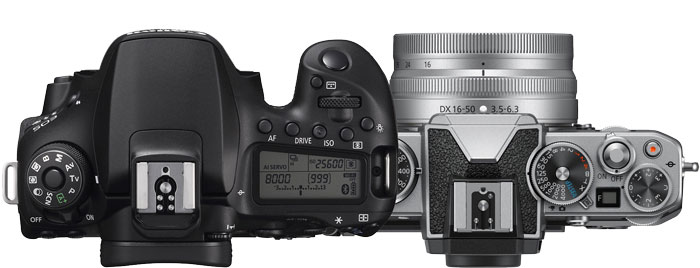
3. Nikon Zfc vs Canon 90D – Specification Comparison
| Lens Mount |
Nikon Z |
Canon EF-S |
| Camera Format |
APS-C (1.5x Crop Factor) |
APS-C (1.6x Crop Factor) |
| Sensor Resolution |
Actual: 21.51 Megapixel
Effective: 20.9 Megapixel (5568 x 3712) |
Actual: 34.4 Megapixel
Effective: 32.5 Megapixel (6960 x 4640) |
| Aspect Ratio |
1:1, 3:2, 16:9 |
1:1, 3:2, 4:3, 16:9 |
| Sensor Type |
CMOS |
CMOS |
| Sensor Size |
23.5 x 15.7 mm |
22.3 x 14.8 mm |
| Image File Format |
JPEG, Raw |
JPEG, Raw |
| Bit Depth |
14-Bit |
14-Bit |
4. Controlled vs uncontrolled light
Canon 90D features a 32 MO sensor that needs good lenses for proper resolving power (and a good amount of light also). And Nikon Zfc features 20MP low-light sensitive sensor. So, select your camera depending upon your work situation, if you work 90% time in the uncontrolled light environment then for sure Nikon Zfc is best for you and if you work in your studio or you carry a professional light setup with you the Canon 90D will help you more.
| ISO Sensitivity |
Auto, 100 to 51200 (Extended: 100 to 204800) |
Auto, 100 to 25600 (Extended: 100 to 51200) |
| Shutter Speed |
Electronic Front Curtain Shutter
1/4000 to 30 Second
Bulb Mode
Time Mode
Electronic Shutter
1/4000 to 900 Second
Bulb Mode
Time Mode |
Mechanical Shutter
1/8000 to 30 Second
Bulb Mode
Electronic Shutter
1/16000 to 30 Second |
| Metering Method |
Center-Weighted Average, Matrix, Spot |
Center-Weighted Average, Evaluative, Partial, Spot |
| Exposure Modes |
Aperture Priority, Manual, Program, Shutter Priority |
Aperture Priority, Manual, Program, Shutter Priority |
| Exposure Compensation |
-5 to +5 EV (1/3, 1/2 EV Steps) |
-5 to +5 EV (1/3, 1/2 EV Steps) |
| Metering Range |
-4 to 17 EV |
1 to 20 EV |
| Continuous Shooting |
Up to 11 fps at 20.9 MP |
Up to 10 fps at 32.5 MP for up to 25 Frames (Raw) / 58 Frames (JPEG)
Up to 11 fps at 32.5 MP
Up to 7 fps at 32.5 MP |
| Interval Recording |
Yes |
Yes |
5. Over Sampling vs Pixel Binning
Canon 90D does pixel binning in 4k when you do a full sensor readout, although cropped HQ 4k is also an option in the camera. Nikon Zfc easily does the oversampling with a 20MP sensor and delivers a high-quality video with better low-light performance. In my opinion, if you are not a big-fan of Canon color science you should buy the Nikon Zfc camera for video purposes.
| Recording Modes |
H.264/MOV/MP4
UHD 4K (3840 x 2160) at 23.976p/25p/29.97p
Full HD (1920 x 1080) at 23.976p/25p/29.97p/50p/59.94p/100p/119.88p |
H.264/MP4
UHD 4K (3840 x 2160) at 23.976p/25p/29.97p
Full HD (1920 x 1080) at 23.976p/25p/29.97p/50p/59.94p/100p/119.88p
HD (1280 x 720) at 50p/59.94p |
| Recording Limit |
Up to 29 Minutes, 59 Seconds |
4:2:2 8-Bit
UHD 4K (3840 x 2160) up to 25p/29.97p |
| ISO Sensitivity |
Auto/Manual: 100 to 25600 |
Up to 29 Minutes, 59 Seconds |
| Audio Recording |
Built-In Microphone (Stereo)
External Microphone Input (Stereo) |
NTSC |
| Live Streaming |
Yes |
Built-In Microphone (Stereo)
External Microphone Input (Stereo) |
| Webcam Functionality |
Yes |
AAC |
6. The AF points – 5481 vs 205
Despite of having 205 AF points Nikon ZFC doesn’t fail to impress, the AF performance is very good, and being a Nikon camera it never fails to impress you. As usual, we know over 5K+ AF points which are further grouped into 143 AF zones
| Focus Type |
Auto and Manual Focus |
Auto and Manual Focus |
| Focus Mode |
Automatic (A), Continuous-Servo AF (C), Manual Focus (M), Single-Servo AF (S) |
Continuous-Servo AF (C), Manual Focus (M), Single-Servo AF (S) |
| Autofocus Points |
Phase Detection: 209 |
Phase Detection: 45 (45 Cross-Type)
Phase Detection: 5481 |
| Autofocus Sensitivity |
-4.5 to +19 EV |
-3 to +18 EV |
7. Concusion / Verdict
Nikon Zfc is a new and excellent option for those who love to have a camera with extensive manual control and suitable for an uncontrolled light environment. Canon 90D is also an excellent shooting matching but due to the high-resolution sensor, the camera needs better lenses and also a good amount of light for sharp output.
Nikon Zfc camera at Amazon.com and B&H Store
Get Canon 90D from Amazon
By admin, on July 4th, 2021

Best Lenses for Nikon Zfc camera. The Zfc camera is a camera with extensive manual control for professional and semi-pro users. And also uses tried and tested Nikon’s best 20 MP sensor used inside the Nikon Zfc for enhanced for low-light performance. The camera also capture oversampled 4k videos and Full HD up to 120p, above all you are also getting a vari-angel display screen. Perfect for creating vlogs.
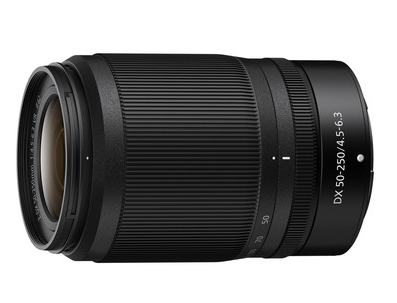
1. Best Zoom Lens for Nikon Zfc Camera
Apart from kit lens, only one lens is available for DX Mirrorless camera right now and the name of the lens is NIKKOR Z DX 50-250mm f/4.5-6.3 VR Lens. They extremely sharp, quick, and light. Highly recommended if you want a handy zoom lens for your DX-format camera. Its compact, balanced design and Vibration Reduction technology help keep photos sharp and videos steady, and the lens’ fast, quiet autofocus system minimizes camera noise during video recording.
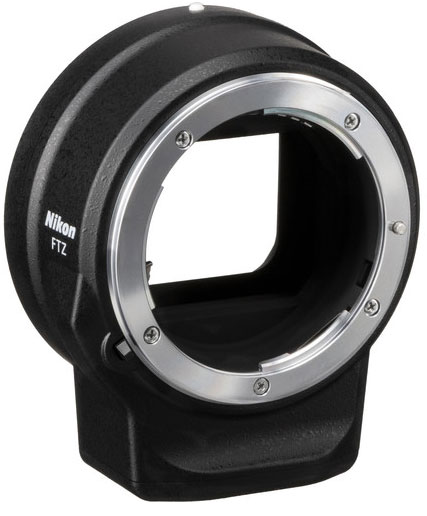
2. Must-Have Accessories for Nikon Zfc
NIKON FTZ Adapter Nikon DX Mirrorless cameras system have very few lenses right now. So, if you want to do a portrait, macro or landscape you have to buy a DX or FX Lens paired with an FTZ adapter to fulfill your shooting requirements.
ALert to use the lenses listed below you have to use FTZ adapter
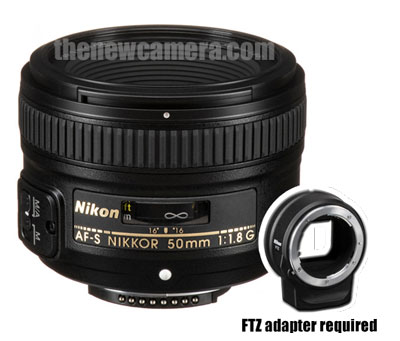
3. Portrait Lens For Nikon Zfc
Nikon 50mm F1.8 The best and most affordable portrait lens for Nikon Zfc is still Nikon 50mm F1.8 Lens. As we all know the Z50mm F1.8S lens cost $496 (Amazon), so if you can afford sure you will get slightly more upscaled images although due to presence of same aperture in both please do not expect and dramatic improvement from the Z50mm F1.8 S Lens.
Affordable portrait package for ZFc camera
Nikon 50mm F1.8 Lens + FTZ adapter (FTZ is a one-time investment and later you can use any DSLR lens with the camera)
If you have a budget of Sline of lenses then better to get the Nikon 50mm F1.4 Lens
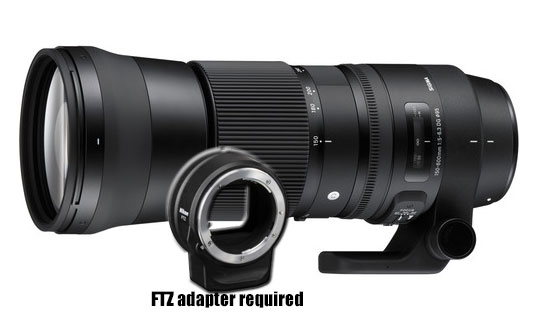
4. Best Zoom Lens for Sports / Wildlife / Nature Landscape
This Sigma 150-600mm f/5-6.3 DG OS HSM Contemporary Lens is the best lens when paired with Nikon Zfc will give you a massive reach of 225 – 1200mm. Although the lens is costly and heavy, the sharpness of the lens is just amazing as well as the tele reach you are getting. When stopped down to f8 it is extremely sharp. It is much sharper than the Tamron 150-600mm. The Optical stabilizer is also good and helps you to take neat and clean hand-held images.
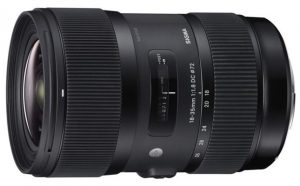
5. Best Alternative to 16-50mm Kit Lens
You can also get Sigma 18-35mm Lens if you want to get Prime lens capability in a zoom lens. Sigma 18-35mm lens features 3 prime lenses inside. The 18mm F1.8, 24mm F1.8, and 35mm F1.8. 18-35mm lens image quality is outstanding and it looks like someone added Zoom ring to a prime lens. We highly recommend you get this lens if you are a prime lens lover.
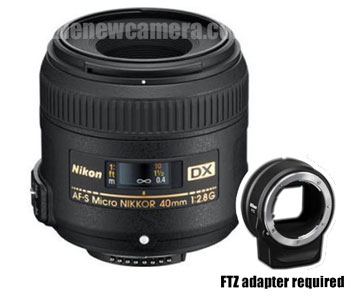
6. Best Macro Lens
Nikon 40mm F2.8 AF-S DX – The best macro & affordable lens for Nikon Zfc is 40mm of 2.8 macro. The lens is very sharp compact and lightweight. 40mm F2.8 is specifically optimized for macro work. And the lens distortion and chromatic aberration are very well controlled and negligible. We can call this lens an economical as well as an excellent performer. A perfect balance of price and features. we highly recommend you get this lens for your New Zfc camera.
By admin, on June 30th, 2021

Nikon Zfc vs Nikon Z50 specification comparison review. Did both the camera features exactly the same core specification or they do have some differences between them. Let’s find out in our detailed specification comparison review.
1. Sensor Comparison Nikon Zfc vs Nikon Z50
| Nikon Z |
Nikon Z |
| APS-C (1.5x Crop Factor) |
APS-C (1.5x Crop Factor) |
Actual: 21.51 Megapixel
Effective: 20.9 Megapixel (5568 x 3712) |
Actual: 21.51 Megapixel
Effective: 20.9 Megapixel (5568 x 3712) |
| 1:1, 3:2, 16:9 |
1:1, 3:2, 16:9 |
| CMOS |
CMOS |
| 23.5 x 15.7 mm |
23.5 x 15.7 mm |
| JPEG, Raw |
JPEG, Raw |
| 14-Bit |
14-Bit |
From the initial set of specifications, it’s very clear that both Nikon Zfc and Nikon Z50 camera features the same sensor.
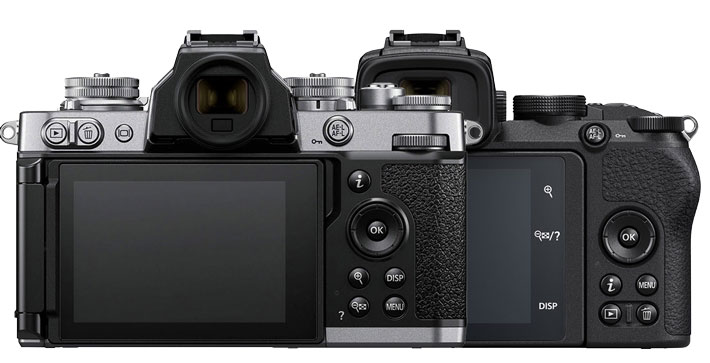
2. Continuous AF Speed, Exposure Control and ISO
| ISO Sensitivity |
Auto, 100 to 51200 (Extended: 100 to 204800) |
Auto, 100 to 51200 (Extended: 100 to 204800) |
| Shutter Speed |
Electronic Front Curtain Shutter
1/4000 to 30 Second
Bulb Mode
Time Mode
Electronic Shutter
1/4000 to 900 Second
Bulb Mode
Time Mode |
Electronic Front Curtain Shutter
1/4000 to 30 Second
Bulb Mode
Time Mode
Electronic Shutter
1/4000 to 30 Second
Bulb Mode
Time Mode |
| Metering Method |
Center-Weighted Average, Matrix, Spot |
Center-Weighted Average, Highlight Weighted, Matrix, Spot |
| Exposure Modes |
Aperture Priority, Manual, Program, Shutter Priority |
Aperture Priority, Manual, Program, Shutter Priority |
| Exposure Compensation |
-5 to +5 EV (1/3, 1/2 EV Steps) |
-5 to +5 EV (1/3, 1/2 EV Steps) |
| Metering Range |
-4 to 17 EV |
-4 to 17 EV |
| Continuous Shooting |
Up to 11 fps at 20.9 MP |
Up to 11 fps at 20.9 MP
Up to 5 fps at 20.9 MP
Up to 4 fps at 20.9 MP
Up to 30 fps at 8 MP |
| Interval Recording |
Yes |
Yes |
|
|
2/5/10/20-Second Delay |
We are not able to spot any minor difference between these two cameras. It looks like a Nikon Z50 camera wrapped inside a Nikon Zfc body.
3. Best Video Camera between the Nikon Zfc and Nikon Z50
| Recording Modes |
H.264/MOV/MP4
UHD 4K (3840 x 2160) at 23.976p/25p/29.97p
Full HD (1920 x 1080) at 23.976p/25p/29.97p/50p/59.94p/100p/119.88p |
MOV/MP4/H.264
UHD 4K (3840 x 2160) at UHD 4K (3840 x 2160) up to 29.97p
Full HD (1920 x 1080) up to 120p |
| Recording Limit |
Up to 29 Minutes, 59 Seconds |
Up to 29 Minutes, 59 Seconds |
| ISO Sensitivity |
Auto/Manual: 100 to 25600 |
Auto/Manual: 100 to 25600 |
| Audio Recording |
Built-In Microphone (Stereo)
External Microphone Input (Stereo) |
Built-In Microphone (Stereo)
External Microphone Input (Stereo) |
| Live Streaming |
Yes |
Yes |
| Webcam Functionality |
Yes |
Yes |
|
|
|
The video specification of both Nikon Zfc and Nikon Z50 exactly the same.

4. Autofocus Speed
| Focus Type |
Auto and Manual Focus |
Auto and Manual Focus |
| Focus Mode |
Automatic (A), Continuous-Servo AF (C), Manual Focus (M), Single-Servo AF (S) |
Automatic (A), Continuous-Servo AF (C), Full-Time Servo (F), Manual Focus (M), Single-Servo AF (S) |
| Autofocus Points |
Phase Detection: 209 |
Phase Detection: 209 |
| Autofocus Sensitivity |
-4.5 to +19 EV |
-2 to +19 EV |
5. Viewfinder and monitor
| Viewfinder Type |
Electronic (OLED) |
Electronic (OLED) |
| Viewfinder Size |
0.39″ |
0.39″ |
| Viewfinder Resolution |
2,360,000 Dot |
2,360,000 Dot |
| Viewfinder Eye Point |
20 mm |
20 mm |
| Viewfinder Coverage |
100% |
100% |
| Viewfinder Magnification |
Approx. 1.02x |
Approx. 1.02x |
| Diopter Adjustment |
-3 to +3 |
-3 to +3 |
|
|
3.2″ |
| Resolution |
|
1,040,000 Dot |
| Display Type |
Vari-angel |
180° Tilting Touchscreen LCD |
Verdict
The core specification of both the camera is almost same. But as you can see we have 4 major differences from the Nikon Z50 camera.
- Extensive manual control
- Vari-angle display screen
- Advance AI AF in camera
- USB power
Why Nikon Z50 is still good for photographers
- Excellent handgrip that Nikon Zfc doesn’t have
Get Nikon Z50 from Amazon.com
Get Nikon ZFc From B&H Store and Amazon.com
Best lenses for Nikon Z50
By admin, on June 30th, 2021

Nikon Zfc Sample Images available now, Take a look at the sample images of the recently announced Nikon Zfc camera. The sample images look good and one of the best part of these sample images are, all the sample images are taken with the native dx-format mirrorless lenses.
High-quality sample images are not available at this moment as the sun become available we will update this page
Nikon is a recently announced camera that features almost the same core specifications as we have seen in the Nikon z50 camera. More about Nikon Zfc here
Get Nikon ZFc From B&H Store and Amazon.com
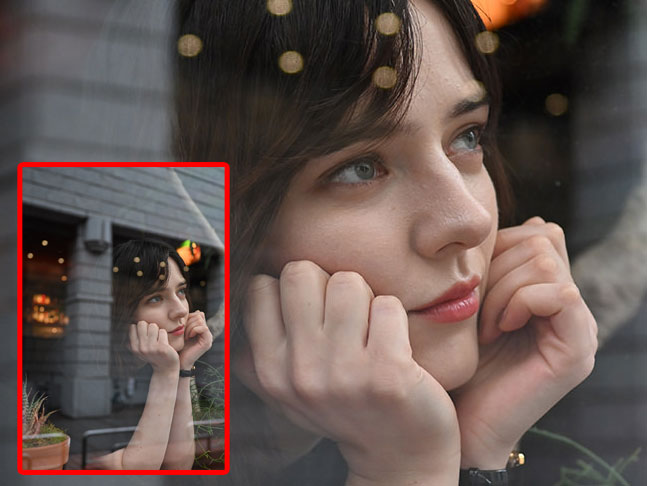
Nikon Zfc Sample image download high resolution from here
| shutter speed |
1/125 seconds |
| Aperture value |
f / 2.8 |
| Focal length |
28mm |
| Metering mode |
Multi-pattern metering |
| Exposure mode |
manual |
| Imaging sensitivity |
ISO 400 |
| White balance |
Auto 1 |
| Picture control |
Auto |
| Image quality mode |
JPEG FINE (8-bit) |
| lens |
NIKKOR Z 28mm f / 2.8 (Special Edition) |
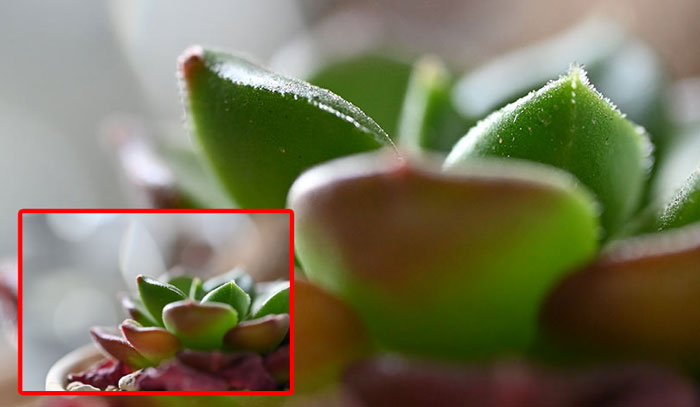
Nikon Zfc Sample image download high resolution from here
| shutter speed |
1/60 seconds |
| Aperture value |
f / 5.6 |
| Focal length |
50mm |
| Metering mode |
Multi-pattern metering |
| Exposure mode |
manual |
| Imaging sensitivity |
ISO 1000 |
| White balance |
Auto 1 |
| Picture control |
Auto |
| Image quality mode |
JPEG FINE (8-bit) |
| lens |
NIKKOR Z MC 50mm f / 2.8 |
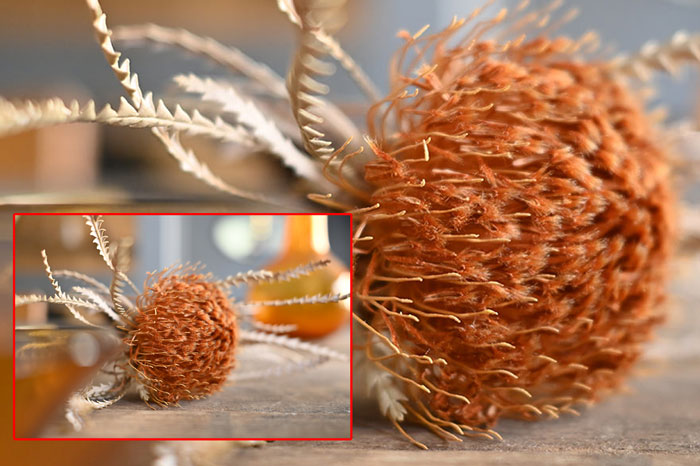
Download high-resolution sample image from here
| shutter speed |
1/30 second |
| Aperture value |
f / 2.8 |
| Focal length |
28mm |
| Metering mode |
Multi-pattern metering |
| Exposure mode |
manual |
| Imaging sensitivity |
ISO 400 |
| White balance |
Natural light auto |
| Picture control |
Auto |
| Image quality mode |
JPEG FINE (8-bit) |
| lens |
NIKKOR Z 28mm f / 2.8 (Special Edition) |
|
KEEP THIS BLOG ALIVE - Support New Camera Buy Canon Lenses, Buy Music CD or Digital Camera at amazon it helps this site, and you do not pay anything extra, it is just a way to help support this site.

|






























